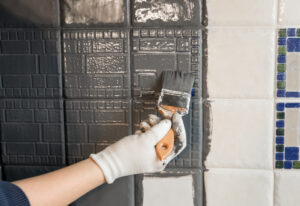How Much Does It Cost to Paint a Bathroom?

*Updated February 19th, 2025
The Benefits of Repainting Your Bathroom
A fresh coat of paint in your bathroom isn’t just about making it look nice—it comes with a range of practical benefits that can improve both the function and feel of the space. Whether you’re aiming to protect your walls, create a more inviting atmosphere, or even boost your home’s value, repainting is a simple yet impactful upgrade. Plus, with the right type of moisture-resistant paint, you can extend the lifespan of your walls while giving your bathroom a stylish refresh. Here’s why a fresh paint job is more than just a cosmetic change:
- Protection from Moisture and Mold: One of the primary advantages of repainting your bathroom is the added layer of protection against moisture. A fresh coat of paint acts as a sealant, reducing the risk of dampness penetrating the walls. This, in turn, inhibits the growth of mold and mildew, ensuring your bathroom remains a healthy space.
- Mood and Ambience Enhancement: The color palette of a room has a profound impact on an individual’s mood and overall feel of the space. By updating the hue of your bathroom, you can transform it into a sanctuary of calm and relaxation or even a vibrant, energizing area. This makes every bath or shower a potentially rejuvenating experience.
- Increased Home Value: Small upgrades can significantly influence a property’s perceived value. A freshly painted bathroom, in modern and appealing shades, can be a standout feature for potential buyers. It not only showcases the care you’ve put into the upkeep of the home but also offers them one less task on their to-do list after purchase. Thus, a simple act of repainting can render considerable returns on investment when it comes time to sell.
Factors that Determine the Cost of Painting a Bathroom
1. Size of the Bathroom
The overall cost of painting your bathroom is closely tied to its dimensions. Larger bathrooms will naturally require more materials and time, adding to the total expense.
2. Condition of the Walls
The condition of your walls also affects the cost of painting. If your walls are in good condition, you may only need a single coat of paint. However, if there are cracks or holes in your walls, you may need to repair them before painting.
3. Type of Paint and Finishes
For moisture-prone areas like bathrooms, it’s essential to opt for paints that resist mold and mildew.
Opting for superior-grade paints, though potentially more costly, ensures extended durability and a richer finish.
The color palette you choose can further affect costs. Some hues might necessitate additional applications to bring out the desired tone, and certain shades might carry a premium due to their current trendiness or limited supply.
4. Labor Costs
Labor costs are another significant factor that determines the cost of painting a bathroom. Professional painters charge an hourly rate that varies depending on their experience.
If your bathroom has intricate details, such as crown molding, wainscoting, or wallpaper, it will also take more time and skill to paint them, which will increase the labor cost.
Calculating the Cost
To calculate the cost of painting your bathroom, you need to consider several factors:
1. Determining the Square Footage
The first step is to determine the square footage of your bathroom walls and ceiling that need to be painted. There are different methods for measuring square footage, but it’s important to be accurate as this will affect your cost estimate.
2. Estimating the Cost of Paint
Once you have determined the square footage, you can estimate the cost of paint based on the average cost per gallon and the amount of paint needed based on square footage.
3. How much paint do I need to buy for my bathroom?
To estimate how much paint you need to buy for your bathroom, you need to know two things : the total area of your bathroom walls and ceiling and the coverage of your chosen paint (which you can find on the label or online). Then, you need to divide the total area by the coverage to get the number of gallons you need.
For example, if your bathroom walls and ceiling have a total area of 100 square feet and your paint has a coverage of 400 square feet per gallon, you need 100 / 400 = 0.25 gallons of paint. However, you should always round up to the nearest whole number (in this case 1 gallon) because it is better to have some extra paint than not enough.
You should also add 10% to 20% more paint to account for waste, spillage, and multiple coats. Therefore, you should buy 1.2 to 1.4 gallons of paint for your bathroom in this scenario.
4. Accounting for Scope of Work
You also need to consider labor costs, which depend on factors such as prep work, repairing damaged walls, removal of wallpaper or previous paint, and additional features like vanity and tiles.
5. Additional Expenses
In addition to paint and labor costs, there are other expenses to consider such as necessary equipment and tools, costs for primer, brushes, and other materials, and potential unexpected expenses.
Sample Cost Breakdown
To give you a better idea of what to expect, here’s a rough breakdown of painting costs for an average-sized bathroom. Keep in mind that prices can vary depending on your location, the type of paint you choose, and whether you hire a professional or tackle the job yourself.
Paint cost: $108 – $145
The type and quality of paint you choose will have a big impact on cost. A moisture-resistant, mold-resistant paint specifically designed for bathrooms tends to be on the higher end of this range. If you opt for a premium brand or need multiple coats for a bold color change, expect to pay even more.
Labor cost: $330 – $798
If you’re hiring a professional, labor will likely be your biggest expense. The complexity of the job also matters—if your bathroom has high ceilings, detailed trim, or requires extensive prep work, the cost will increase. Some painters charge by the hour, while others offer a flat rate, so it’s a good idea to get multiple quotes before committing.
Additional expenses: $7 – $8
Small supplies like painter’s tape, brushes, rollers, drop cloths, and primer (if needed) can add a few extra dollars to your total. If you already have some of these items on hand, you can cut down on this expense.
Total cost: $444 – $951
Tips for Keeping Costs Down
1. DIY vs Hiring a Professional Painter
One way to save money is by doing it yourself instead of hiring a professional painter. However, keep in mind that painting requires skill and experience. If you’re not confident in your abilities, it’s best to hire a professional.
2. Comparison Shopping for Paint and Supplies
Another way to save money is by comparing prices for paint and supplies from different stores. Look for sales or discounts that can help you save money.
3. Proper Preparation to Avoid Extra Costs
Proper preparation is essential to avoid extra costs. Make sure you clean your bathroom thoroughly before painting. Cover any fixtures or surfaces that you don’t want to get paint on.
Final Thoughts
A fresh coat of paint is one of the easiest and most affordable ways to breathe new life into your bathroom. Whether you’re going for a bold, modern vibe or a soothing spa-like retreat, the right color can completely transform the space. Plus, with a little planning and budgeting, you can achieve a high-end look without spending a fortune.
Before you start, take time to choose the right paint type (hello, moisture resistance!), gather your supplies, and decide whether you’ll DIY or hire a pro. No matter your approach, a well-done paint job can make your bathroom feel fresh, clean, and stylish—all without a major renovation. So, grab that paintbrush and get ready to give your bathroom the upgrade it deserves!
Additional Bathroom Remodel Resources
- Bathroom Remodel ROI – What Can You Expect?
- 2024 Bathroom Remodel Cost Guide
- Guide to a Mobile Home Bathroom Remodel
- How to Waterproof Wood for a Bathroom

Anna has over six years of experience in the home services and journalism industries and serves as the Content Manager at MyHomePros.com, specializing in making complex home improvement topics like HVAC, roofing, and plumbing accessible to all. With a bachelor’s degree in journalism from Auburn University, she excels in crafting localized, comprehensive guides that cater to homeowners’ unique needs. Living on both coasts of the United States has equipped her with a distinctive perspective, fueling her passion for turning any house into a cherished home through informed, personalized decision-making.






